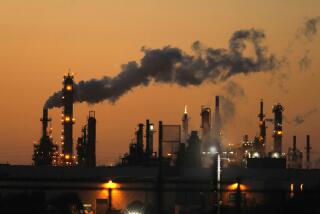Air Pollution Estimates Called Flawed
- Share via
Oil refineries and other large industrial polluters are making major errors in estimating their emissions, which means air quality officials are basing critical smog-fighting decisions on “outdated, incomplete or inaccurate” numbers, according to a University of Southern California study.
USC environmental engineer Ronald Henry, who led a study of Houston petrochemical industries published recently in the Proceedings of the National Academy of Sciences, said pollution rates reported by companies are “egregiously wrong” with “enormous variations between what we thought should be [in the air] and what we actually saw there.”
The primary problem, said Henry, is that oil refineries and other large industries calculate the tons of pollutants they release using complex mathematical formulas and occasional checks for leaks in some of their equipment. If they instead performed comprehensive testing of the air around their plants, the pollution inventories would be far more precise, he said.
Since inventories are conducted in similar ways nationwide, Henry suspects reports from California companies also are probably failing to portray reality.
The accuracy of these inventories is vital to the Los Angeles region’s multibillion-dollar efforts to clean up smog. The South Coast Air Quality Management District plugs the numbers into computer models that simulate future air quality and gauge how far rules must go to ensure that residents breathe healthful air.
“We’re really in fantasyland right now when it comes to this stuff,” Henry said. “We’ve been lucky so far [in cleaning up smog], but we’re at the point now where our luck has probably run out and we need to pay attention to these issues we have swept under the rug.”
For six months, the research team collected automated, hourly measurements of 54 volatile organic compounds, or hydrocarbons, in Houston’s Ship Channel, a massive complex of oil refineries and chemical plants. The detected fumes were then compared to the reports the companies filed with the state of Texas.
The quantity, as well as the chemical composition, rarely matched--the amount of real emissions was as much as hundreds of times more or less than the companies reported, Henry said.
Although Henry believes some miscalculations may be deliberate, he thinks most are unintentional. In fact, some Houston refineries reported polluting more than they actually are. One reported that it was a major source of a pollutant even though the researchers found no trace even when the refinery operated at full capacity.
“There is no pattern of widespread misrepresentation,” he said. “It’s a matter of people working with a system that is broken.”
Southern California oil refinery managers said they believe their reporting is accurate and they go to great lengths to verify it.
“We have a great deal of confidence in our testing program and in the reporting that we do to the [AQMD]. We feel it is very accurate,” said Carolyn Keith, a spokeswoman at Mobil’s refinery in Torrance. “And the AQMD doesn’t assume that your monitoring program is going along on its own accurately. They do unannounced visits where they make sure the reporting is accurate.”
Glenn Sparks, Mobil’s environmental program supervisor, said the Houston data is probably not relevant to the Los Angeles area, where industries face the nation’s toughest pollution rules. Under AQMD rules, each refinery must regularly inspect parts of its operation for fumes, especially thousands of valves and other pipeline components that can leak.
“We monitor about 140,000 points at this refinery on a quarterly basis,” he said. “We have about 11 people working full time, just monitoring those particular points.”
In addition, storage tanks are inspected yearly and sewer systems are checked for fumes.
Henry acknowledges that Los Angeles area refineries have the best pollution controls in the nation, but he suspects that the occasional inspections do not ensure that the inventories are accurate. Flawed formulas, unnoticed leaks or out-of-date data could be at fault, and Henry said full-scale measuring of the air around the plants--as he did in Houston--should be required as a “reality check.”
“In spite of the best efforts of government and industry,” the study says, “the emissions from refineries and chemical plants are notoriously hard to determine.”
The Houston study, commissioned by the state of Texas, says the “severe inconsistencies” in company reports “can severely impact” the models that decision-makers rely on to draft battle plans for combating smog.
If industrial emissions are underestimated here, the Los Angeles region may not reach health standards for ozone, the main ingredient of smog, by 2010 as required under federal law. If they are overestimated, costly rules can be enacted with little benefit.
The AQMD has already come under fire for its computer modeling of smog. Last fall, the agency’s scientific advisors resigned, and one of their main complaints was that AQMD staffers had altered pollution estimates without independent analysis. The agency’s more optimistic predictions allowed several dozen proposed measures targeting businesses to be dropped.
The AQMD relies on about 3,800 companies in Los Angeles, Orange, Riverside and San Bernardino counties to self-report their annual emissions. Spokesman Bill Kelly said the agency has no plans to alter its requirements or study whether the reported inaccuracies in Houston reflect what occurs in the Los Angeles area.
Kelly said “it’s hard to believe” that the emission estimates used by the AQMD could be off by orders of magnitude. In the Los Angeles Basin, such a large discrepancy at oil refineries would amount to hundreds of tons of hydrocarbons daily.
“We believe the method we have is reasonably good, although there’s always going to be some imprecision,” he said. “It’s not a precise inventory and it’s not a precise modeling capability, so it would not be surprising that the reporting and measuring of emissions could be improved.”
More to Read
Sign up for Essential California
The most important California stories and recommendations in your inbox every morning.
You may occasionally receive promotional content from the Los Angeles Times.










